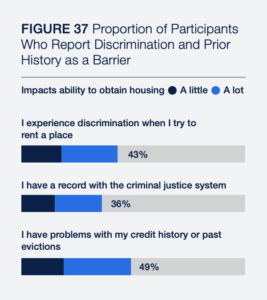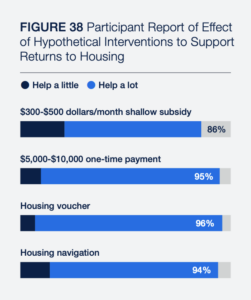In early June, the Benioff Homelessness and Housing Initiative (BHHI), housed at the University of California San Francisco, released a groundbreaking report on the characteristics and causes of homelessness in California. The report, which was principally authored by Dr. Margot Kushel and Dr. Tiana Moore, provides a wealth of information about why people fell into homelessness, what they need to end their homelessness, health, mental health, substance use, prior system involvement, and other issues.
The study took a mixed methods approach, combining data from more than 3,000 surveys with an additional 365 in-depth interviews conducted between October 2021 and November 2022 with people across a wide-spanning and representative geographic sample of California.
While we can’t say for certain that the phenomena highlighted are being replicated across the country, diversity of California is in many ways reflective of the diversity of the nation: homeless Californians were surveyed in urban, rural, and suburban settings for this study, as were people of a wide range of racial and ethnic backgrounds, and all ages. Policymakers should take heed nationwide and review the surfeit of data available here. In addition to reinforcing the existing—and alarming—trends around both an aging population and disproportionate representation of communities of color among those experiencing homelessness, there were several findings from the report that stand out.
Lack of Affordable Housing Continues to Drive Homelessness, Exacerbate Other Conditions
Skyrocketing rental prices remain a top contributor to the rise in homelessness. The report finds that 58 percent of former leaseholders experiencing homelessness lost housing due to economic conditions, most of whom point to high rent costs as the primary cause of their homelessness. People also cited affordability as a primary barrier to exiting homelessness; 89 percent of survey respondents noted that affordability was a barrier to re-entering housing.
How Tenancy and Leaseholding Impacts Entries Into Homelessness

The report also details how the affordable housing crisis is forcing many people to find creative but unstable housing arrangements where they lack a formal lease, such as “doubling up” with friends or family. Almost half of BHHI survey participants entered homelessness from non-lease holding arrangements. More than 30 percent of homeless individuals who lost their homes after being forced out of their lease; among them, the median notice before losing their housing was 10 days. For non-leaseholders, the median notice before losing housing was only one day, leaving them with far less time to find new housing. This suggests that while tenant protections are inadequate, they hold a key to giving a little extra time that can be the difference between preventing homelessness and failing to do so.
Along with inadequate protection for both lease and non-leaseholders, tenants trying to exit homelessness often face housing market discrimination. Survey respondents cited screening policies that deny prospective tenants based on credit history, eviction history, and criminal history as major barriers to exiting homelessness.
Housing Assistance Helps to End Homelessness

The vast majority of survey participants cite housing subsidies or cash assistance as the most effective means to end their homelessness. Of those surveyed, 96 percent said a Housing Choice Voucher would help a little or a lot, 94 percent said housing navigation services would help a little or a lot, and 86% noted that a $300-$500 monthly shallow subsidy would help a little or a lot. Together, these findings suggest that the most effective mechanisms to end homelessness require lowering economic burdens and providing assistance to navigate the competitive housing market.
Criminal Legal System Involvement Drives and Prolongs Homelessness
The report provides data suggesting criminalization and the criminal legal system are a driver of homelessness and a barrier to ending it. Of those surveyed, 79 percent report experience of incarceration; about one in five participants report going to jail or prison in the six months prior to their experience of homelessness, while the report details just how few re-entry supports exist for this population. Additionally, the report details that nearly a third of participants went to jail at some point during their experience of homelessness (including 38 percent of those unsheltered without a vehicle). Taken together, incarceration, homelessness, and subsequent criminalization appear to be fueling a vicious cycle for marginalized people – especially Black and Latino Californians – which both causes and prolongs homelessness.
How Substance Use Impacts Homelessness
The report details that substance use among people experiencing homelessness is common, with 35 percent of respondents reporting regular substance use, but adds key nuances that harpoon common conceptions of substance use among this population. A large portion of those who reported regular substance use (20 percent) reported that they wanted treatment options but were unable to access them. Moreover, many respondents reported using substances as a way to address the challenges of living on the street, such as using methamphetamines to remain awake at night to guard against theft, to stave off hunger, or to provide sufficient energy to earn income during the day.
Improving Access to Mental Health Services
A significant portion of individuals experiencing homelessness reported mental health challenges, with about half reporting depression, half reporting anxiety, and over a third reporting difficulty concentrating or remembering things. A smaller percentage (12 percent) reported hallucinations. While these conditions were most common in single adults surveyed, they were similarly prevalent among all populations. These participants, however, note barriers to accessing services even when they’ve tried seeking counseling. Additionally, participants noted challenges accessing medications, or in some cases, losing medications due to being forced to move, with one participant noting, “I haven’t had my meds…a couple weeks ago when I had to leave to a different place, all my things were taken. So I haven’t had meds in a couple weeks, and I’m on a few of them. So, definitely depression has been a lot worse…”
Takeaways
This report covers many more areas that shed needed light on homelessness, providing both data and narrative that challenge some popular assumptions. In addition, the report stands out for its thoughtful and intentional engagement of people with lived experience of homelessness, and its findings are useful for anyone looking to deepen their understanding of homelessness.

